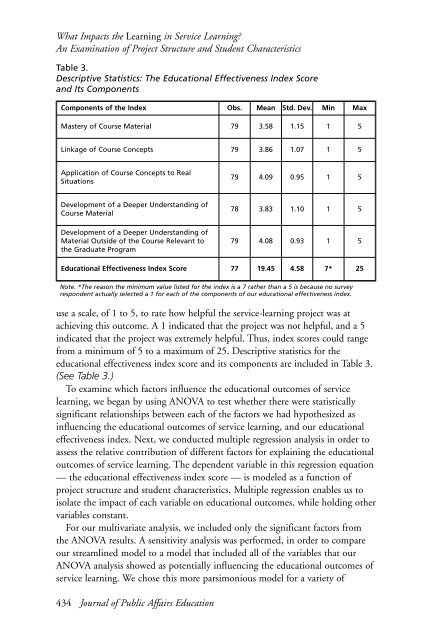JOURNAL OF PUBLIC AFFAIRS EDUCATION - National ...
JOURNAL OF PUBLIC AFFAIRS EDUCATION - National ...
JOURNAL OF PUBLIC AFFAIRS EDUCATION - National ...
You also want an ePaper? Increase the reach of your titles
YUMPU automatically turns print PDFs into web optimized ePapers that Google loves.
What Impacts the Learning in Service Learning?<br />
An Examination of Project Structure and Student Characteristics<br />
Table 3.<br />
Descriptive Statistics: The Educational Effectiveness Index Score<br />
and Its Components<br />
Components of the Index Obs. Mean Std. Dev. Min Max<br />
Mastery of Course Material 79 3.58 1.15 1 5<br />
Linkage of Course Concepts 79 3.86 1.07 1 5<br />
Application of Course Concepts to Real<br />
Situations<br />
Development of a Deeper Understanding of<br />
Course Material<br />
Development of a Deeper Understanding of<br />
Material Outside of the Course Relevant to<br />
the Graduate Program<br />
Note. *The reason the minimum value listed for the index is a 7 rather than a 5 is because no survey<br />
respondent actually selected a 1 for each of the components of our educational effectiveness index.<br />
use a scale, of 1 to 5, to rate how helpful the service-learning project was at<br />
achieving this outcome. A 1 indicated that the project was not helpful, and a 5<br />
indicated that the project was extremely helpful. Thus, index scores could range<br />
from a minimum of 5 to a maximum of 25. Descriptive statistics for the<br />
educational effectiveness index score and its components are included in Table 3.<br />
(See Table 3.)<br />
To examine which factors influence the educational outcomes of service<br />
learning, we began by using ANOVA to test whether there were statistically<br />
significant relationships between each of the factors we had hypothesized as<br />
influencing the educational outcomes of service learning, and our educational<br />
effectiveness index. Next, we conducted multiple regression analysis in order to<br />
assess the relative contribution of different factors for explaining the educational<br />
outcomes of service learning. The dependent variable in this regression equation<br />
— the educational effectiveness index score — is modeled as a function of<br />
project structure and student characteristics. Multiple regression enables us to<br />
isolate the impact of each variable on educational outcomes, while holding other<br />
variables constant.<br />
For our multivariate analysis, we included only the significant factors from<br />
the ANOVA results. A sensitivity analysis was performed, in order to compare<br />
our streamlined model to a model that included all of the variables that our<br />
ANOVA analysis showed as potentially influencing the educational outcomes of<br />
service learning. We chose this more parsimonious model for a variety of<br />
434 Journal of Public Affairs Education<br />
79 4.09 0.95 1 5<br />
78 3.83 1.10 1 5<br />
79 4.08 0.93 1 5<br />
Educational Effectiveness Index Score 77 19.45 4.58 7* 25

















